Assessing the Resource Potential of Mountainous Forests: A Comparison between Austria and Japan
Abstract
:1. Introduction
2. Materials and Methods
2.1. Data
2.2. Method
3. Results
3.1. Dominant Tree Species
3.2. Current Forest Conditions and Historic Development
3.3. Volume Increment
3.4. Age-Class Distribution
3.5. Wood Demand and Supply
4. Discussion
5. Conclusions
Author Contributions
Funding
Institutional Review Board Statement
Informed Consent Statement
Data Availability Statement
Acknowledgments
Conflicts of Interest
References
- FA. Annual Report on Trends in Forest and Forestry in Japan. In Summary Fiscal Year 2017; Ministry of Agriculture, Forestry and Fisheries: Tokyo, Japan, 2017. [Google Scholar]
- Lundbäck, M.; Persson, H.; Häggström, C.; Nordfjell, T. Global Analysis of the Slope of Forest Land. For. Int. J. For. Res. 2021, 94, 54–69. [Google Scholar] [CrossRef]
- BMLFUW. Sustainable Forest Management Report—Austrian Forest Report 2015; Forest Report; Austrian Federal Ministry of Agriculture, Forestry, Environment and Water Management: Vienna, Austria, 2015.
- Fujiwara, M. Silviculture in Japan. In Forestry and the Forest Industry in Japan; Iwai, Y., Ed.; UBC Press: Vancouver, BC, Canada, 2002; pp. 10–23. [Google Scholar]
- Akao, K.i. Private Forestry. In Forestry and the Forest Industry in Japan; Iwai, Y., Ed.; UBC Press: Vancouver, BC, Canada, 2002; pp. 24–40. [Google Scholar]
- FA. State of Japan’s Forests and Forest Management; Country Report of Japan to the Montreal Process 3; Forest Agency: Tokyo, Japan, 2019.
- Hein, S.; Kimura, S.; Bastian, K. Forestry and the Wood Industry in Japan—Part 2. Holz-Zentralblatt 2014, 19, 488–489. (In German) [Google Scholar]
- Hein, S.; Kimura, S.; Bastian, K. Forestry and the Wood Industry in Japan—Part 3. Holz-Zentralblatt 2014, 19, 515–516. (In German) [Google Scholar]
- Masaki, T.; Oguro, M.; Yamashita, N.; Otani, T.; Utsugi, H. Reforestation Following Harvesting of Conifer Plantations in Japan: Current Issues from Silvicultural and Ecological Perspectives. REFORESTA 2017, 3, 125–142. [Google Scholar] [CrossRef] [Green Version]
- Matsushita, K.; Yoshida, Y.; Senda, T. Household Composition and Aging of Forest Owners in Japan. Austrian J. For. Sci. 2017, 134, 101–139. [Google Scholar]
- Fuchigami, Y.; Hara, K.; Uwasu, M.; Kurimoto, S. Analysis of the Mechanism Hindering Sustainable Forestry Operations: A Case Study of Japanese Forest Management. Forests 2016, 7, 182. [Google Scholar] [CrossRef] [Green Version]
- Hirata, Y.; Matsumoto, M.; Iehara, T. Japanese National Forest Inventory and Its Spatial Extension by Remote Sensing. In Proceedings of the Eighth Annual Forest Inventory and Analysis Symposium, Monterey, CA, USA, 16–19 October 2006; pp. 13–17. [Google Scholar]
- FA. Annual Report on Trends in Forest and Forestry in Japan. In Summary Fiscal Year 2019; Ministry of Agriculture, Forestry and Fisheries: Tokyo, Japan, 2019. [Google Scholar]
- Kuboyama, H.; Hori, Y.; Ishizaki, R. Changes in log production and distribution structure in Austria: Focusing on small and medium-sized foresters in Styria. Jpn. For. Econ. Soc. 2012, 58, 37–47. (In Japanese) [Google Scholar] [CrossRef]
- Nemestothy, S.; Grabner, M. Austrian Logging: A Historical Account of the Time of Felling and Debarking, and Transportation Practices. Int. J. Wood Cult. 2021, 1, 180–195. [Google Scholar] [CrossRef]
- Kajiyama, K. Forestry in Finland and Austria, Connecting small-scale ownership and large-scale demand—Structural analysis of Japanese forestry in comparison with advanced European forestry areas. Hayashi Keikyo Mon. Rep. 2002, 2–20. (In Japanese) [Google Scholar]
- Shirai, Y. Forest Roads in Austria. J. Jpn. For. Eng. Soc. 2007, 22, 205–210. (In Japanese) [Google Scholar]
- FA. Annual Report on Trends in Forest and Forestry in Japan. In Summary Fiscal Year 2009; Ministry of Agriculture, Forestry and Fisheries: Tokyo, Japan, 2009. [Google Scholar]
- Kuboyama, H. Recent Changes in Austrian Forestry—A Comparison with Japan. For. Sci. 2013, 68, 9–12. (In Japanese) [Google Scholar] [CrossRef]
- Speidel, G. The Law of Mass Per Piece and Its Importance for the International Comparison of Performance in Forest Work; Schriftenreihe des Instituts für Forstliche Arbeitswissenschaft, Universität Hamburg: Reinbek, Germany, 1952. [Google Scholar]
- Fick, S.E.; Hijmans, R.J. WorldClim 2: New 1-Km Spatial Resolution Climate Surfaces for Global Land Areas. Int. J. Climatol. 2017, 37, 4302–4315. [Google Scholar] [CrossRef]
- BMLRT. Austrian Market Report 2020; Statement, Federal Ministry of Agriculture, Regions and Tourism Directorate-General III—Forestry and Sustainability: Vienna, Austria, 2020.
- FRDS. Brief on National Forest Inventory NFI—Japan; NFI-Brief MAR-SFM Working Paper 19/2007; Forestry Department of the Food and Agriculture Organization of the United Nations: Rome, Italy, 2007. [Google Scholar]
- Hirata, Y.; Hosoda, K.; Nishizono, T.; Kitahara, F.; Nagame, I.; Nakamura, M. The Japanese National Forest Inventory. In National Forest Inventories: Assessment of Wood Availability and Use; Vidal, C., Alberdi, I., Hernández, L., Redmond, J.J., Eds.; Springer International Publishing: Berlin, Germany, 2016; pp. 507–520. [Google Scholar] [CrossRef]
- Egusa, T.; Kumagai, T.; Shiraishi, N. Carbon Stock in Japanese Forests Has Been Greatly Underestimated. Sci. Rep. 2020, 10, 7895. [Google Scholar] [CrossRef] [PubMed]
- van Laar, A.; Akça, A. Forest Mensuration, 2nd ed.; Managing Forest Ecosystems; Springer: Dordrecht, The Netherlands, 2007. [Google Scholar] [CrossRef]
- Braun-Blanquet, J. Plant Sociology; Springer: Vienna, Austria, 1964. [Google Scholar] [CrossRef]
- Schieler, K.; Hauk, E. Instructions for Field Work—Austrian National Forest Inventory 2000–2002, 2001 ed.; FBVA: Vienna, Austria, 2001. (In German) [Google Scholar]
- Bruce, D. Yield Differences between Research Plots and Managed Forests. J. For. 1977, 75, 14–17. [Google Scholar] [CrossRef]
- Bitterlich, W. Angle-Count Sampling. Ph.D. Thesis, Hochschule für Bodenkultur, Vienna, Austria, 1949. [Google Scholar]
- Schieler, K. Incerment Calculation Methods of the Austrian National Forst Inventory. Ph.D. Thesis, University of Natural Resources and Life Sciences, Vienna, Austria, 1997. [Google Scholar]
- Gabler, K.; Schadauer, K. Methods of the Austrian Forest Inventory 2000/02—Origins, Approaches, Design, Sampling, Data Models, Evaluation and Calculation of Standard Error. BFW-Berichte; Schriftenreihe des Bundesforschungs- und Ausbildungszentrum für Wald: Vienna, Austria, 2008; Volume 142, pp. 1–121. [Google Scholar]
- BMLFUW. Data Collection for the Austrian Forest Report 2015; Forest Report; Austrian Federal Ministry of Agriculture, Forestry, Environment and Water Management: Vienna, Austria, 2015.
- R Core Team. R: A Language and Environment for Statistical Computing; R Foundation for Statistical Computing: Vienna, Austria, 2021. [Google Scholar]
- Wickham, H. Ggplot2: Elegant Graphics for Data Analysis; Springer: New York, NY, USA, 2016. [Google Scholar]
- Yamaya, K.; Kato, R.; Mori, M.; Goto, K. Growth Conditions of the Plantations of Chamaecyparis Obtusa and Its Silvicultural Problems in the Tohoku District, Japan. Bull. For. For. Prod. Res. Inst. Jpn. 1984, 325, 1–96. [Google Scholar]
- Fujimori, T. Ecological and Silvicultural Strategies for Sustainable Forest Management, 1st ed.; Elsevier: Amsterdam The Netherlands; New York, NY, USA, 2001. [Google Scholar]
- Futai, K. Pine Wilt in Japan: From First Incidence to the Present. In Pine Wilt Disease; Zhao, B.G., Futai, K., Sutherland, J.R., Takeuchi, Y., Eds.; Springer: Tokyo, Japan, 2008; pp. 5–12. [Google Scholar] [CrossRef]
- Savill, P. Cryptomeria japonica (Thunb. Ex L.f.) D.Don Japanese Red Cedar, or Sugi: Silviculture and Properties. Q. J. For. 2015, 109, 97–102. [Google Scholar]
- Yamamoto, S.I. Regeneration Ecology of Chamaecyparis obtusa and Chamaecyparis pisifera (Hinoki and Sawara Cypress), Japan. In Coastally Restricted Forests; Laderman, A.D., Ed.; Biological Resources Managment Series; Oxford University Press: Oxford, UK, 1998; pp. 101–110. [Google Scholar]
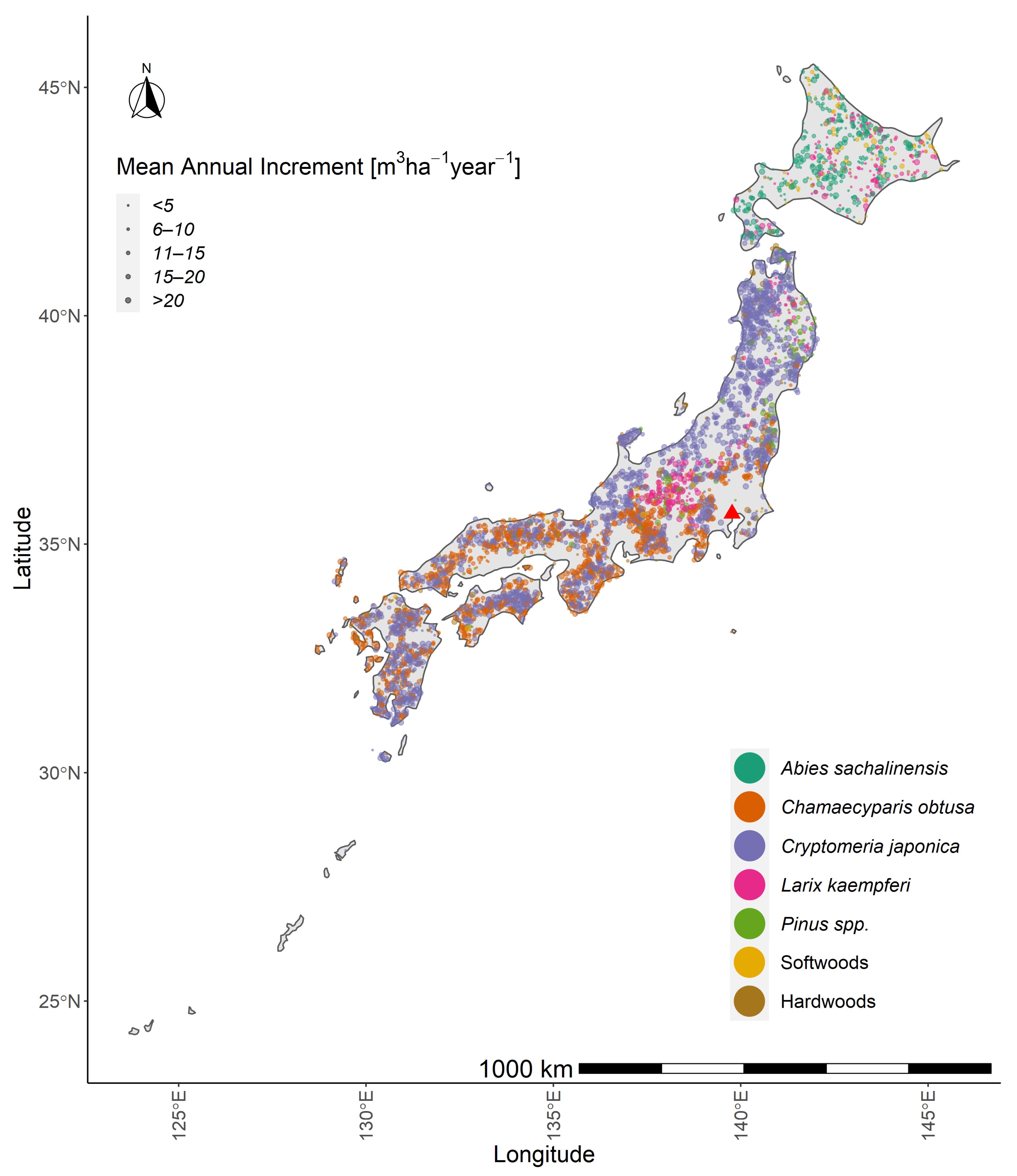
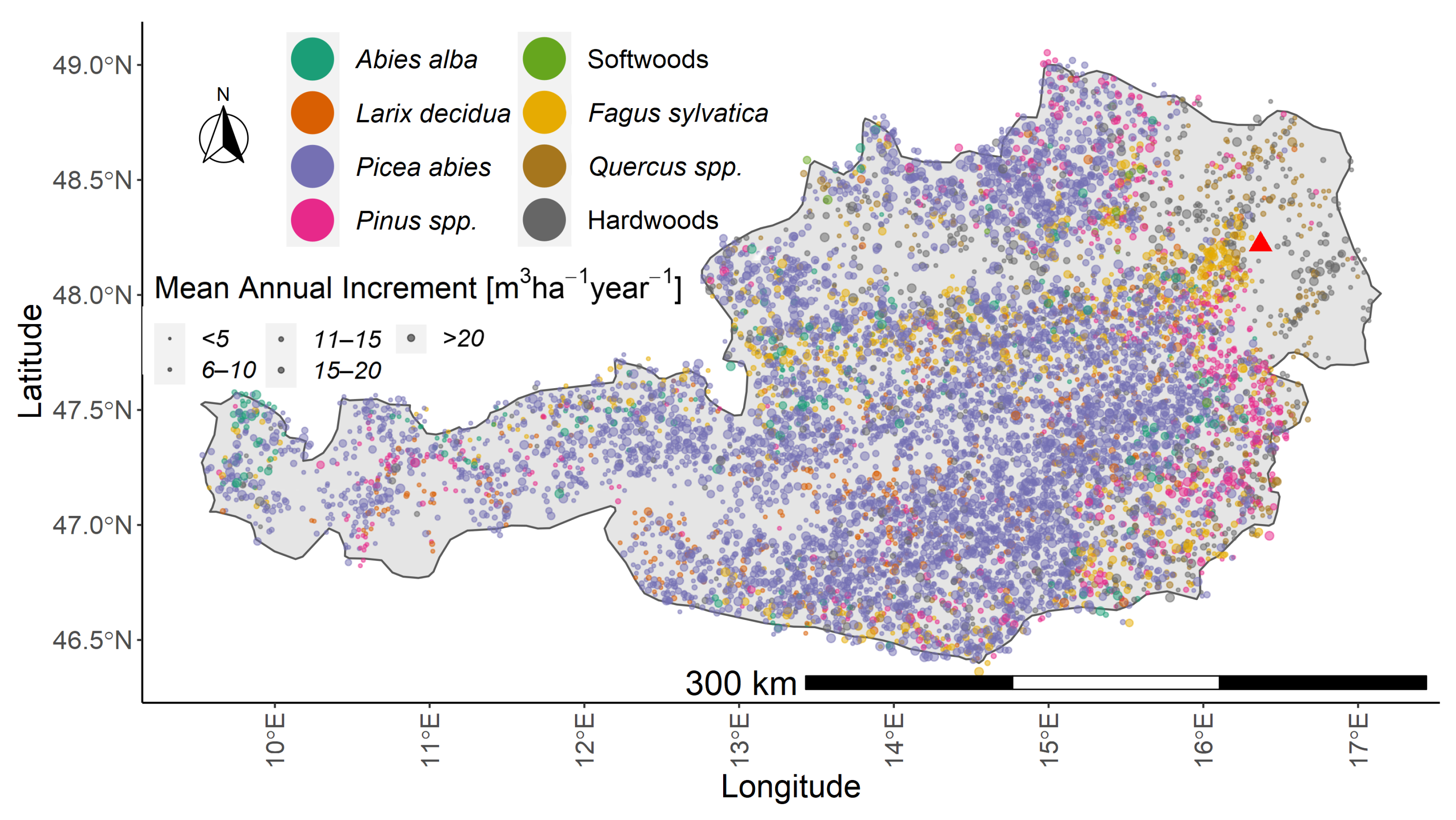

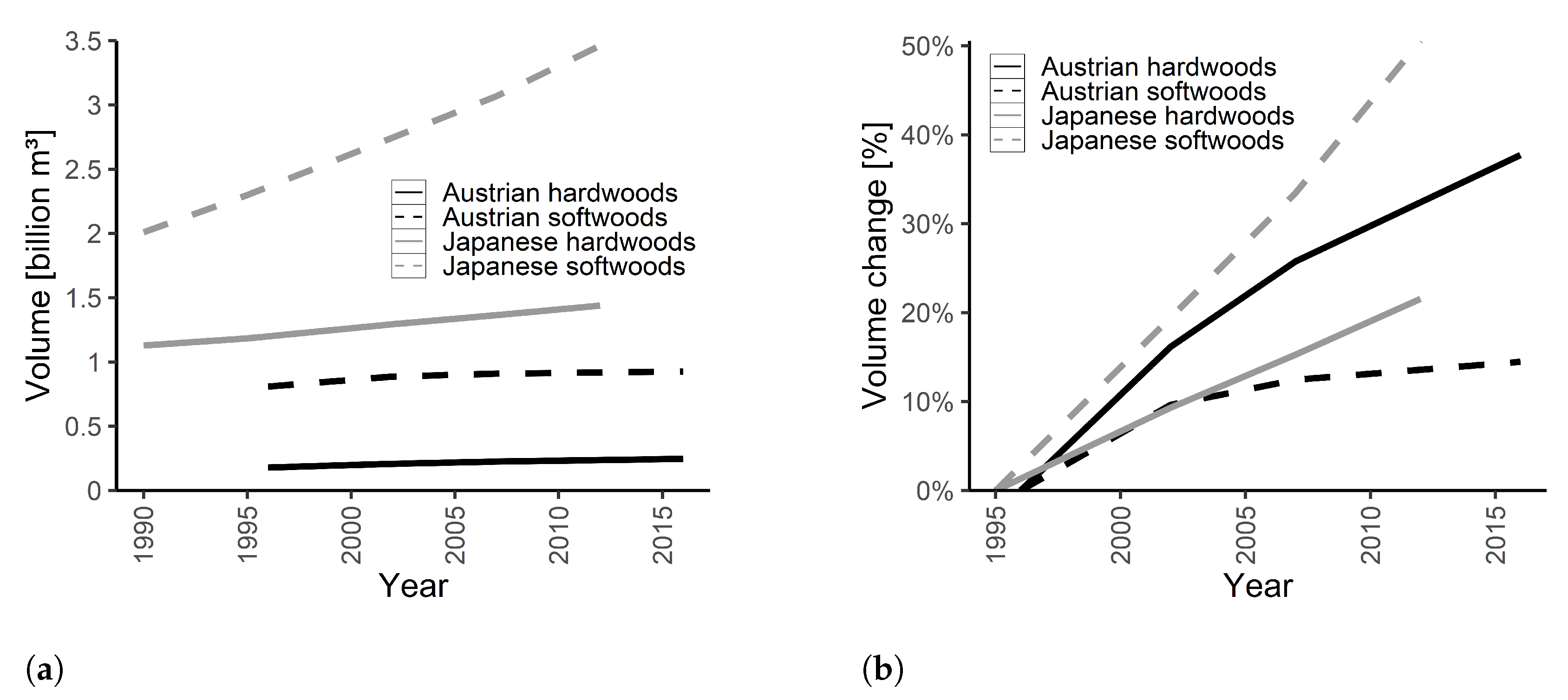
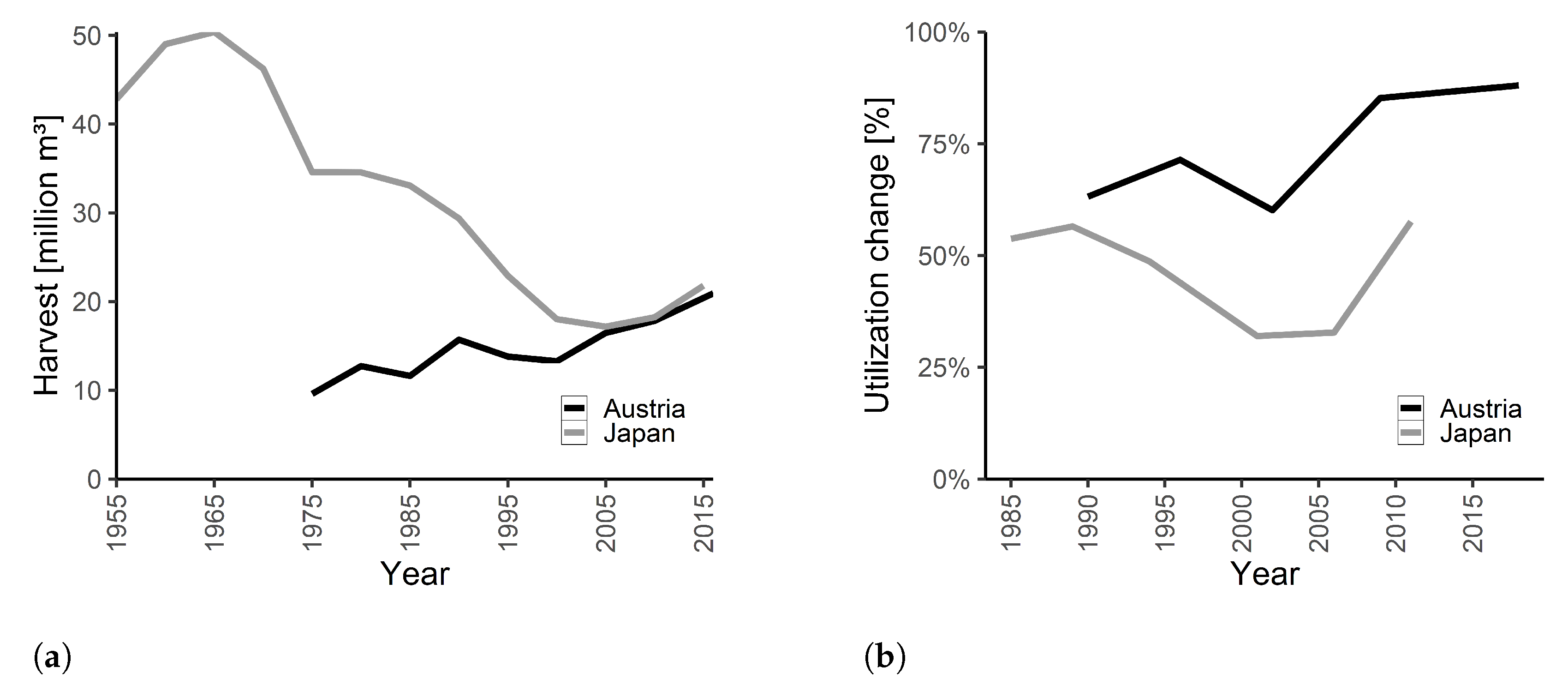

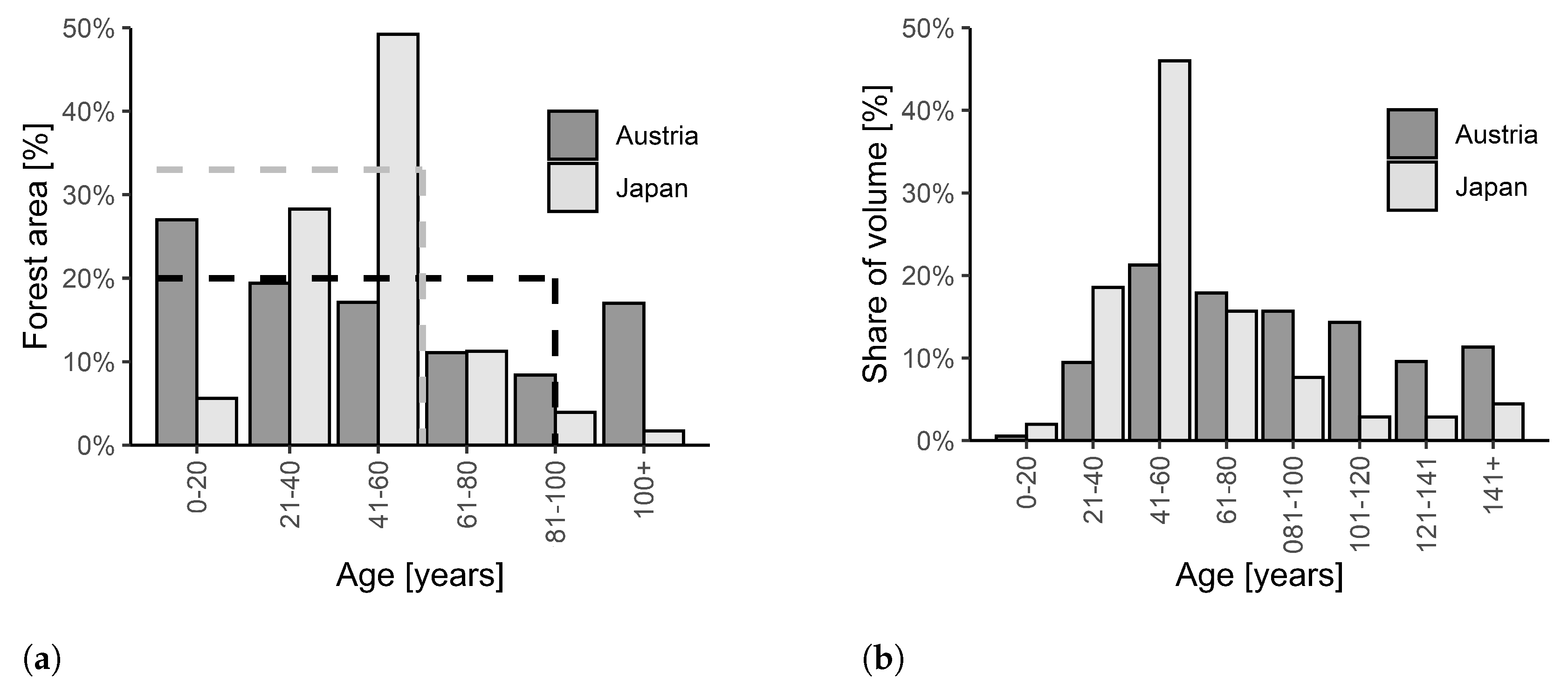
| Species in Austria | English/Japanese Name | Volume (%) |
|---|---|---|
| Picea abies (L.) H.Karst. | Norway spruce | 60.4 |
| Fagus sylvatica L. | European beech | 10.0 |
| Larix decidua Mill. | European larch | 6.6 |
| Pinus sylvestris L. | Scots pine | 6.2 |
| Abies alba Mill. | Silver fir | 4.4 |
| Other softwoods | 1.4 | |
| Other hardwoods | 11 | |
| Japan | ||
| Cryptomeria japonica L.f. | Sugi | 35.7 |
| Chamaecyparis obtusa Siebold and Zucc. | Hinoki | 15.2 |
| Abies sachalinensis F.Schmidt | Todomatsu | 6.2 |
| Pinus densiflora Siebold | Akamatsu | 5.0 |
| Quercus serrata Murray | Konara | 5.5 |
| Fagus crenata Blume | Buna | 4.2 |
| Larix kaempferi Lamb. | Karamatsu | 3.9 |
| Quercus crispula Blume | Mizunara | 3.1 |
| Other softwoods | 3.0 | |
| Other hardwoods | 18.2 |
Publisher’s Note: MDPI stays neutral with regard to jurisdictional claims in published maps and institutional affiliations. |
© 2022 by the authors. Licensee MDPI, Basel, Switzerland. This article is an open access article distributed under the terms and conditions of the Creative Commons Attribution (CC BY) license (https://creativecommons.org/licenses/by/4.0/).
Share and Cite
Leiter, M.; Neumann, M.; Egusa, T.; Harashina, K.; Hasenauer, H. Assessing the Resource Potential of Mountainous Forests: A Comparison between Austria and Japan. Forests 2022, 13, 891. https://doi.org/10.3390/f13060891
Leiter M, Neumann M, Egusa T, Harashina K, Hasenauer H. Assessing the Resource Potential of Mountainous Forests: A Comparison between Austria and Japan. Forests. 2022; 13(6):891. https://doi.org/10.3390/f13060891
Chicago/Turabian StyleLeiter, Mathias, Mathias Neumann, Tomohiro Egusa, Koji Harashina, and Hubert Hasenauer. 2022. "Assessing the Resource Potential of Mountainous Forests: A Comparison between Austria and Japan" Forests 13, no. 6: 891. https://doi.org/10.3390/f13060891
APA StyleLeiter, M., Neumann, M., Egusa, T., Harashina, K., & Hasenauer, H. (2022). Assessing the Resource Potential of Mountainous Forests: A Comparison between Austria and Japan. Forests, 13(6), 891. https://doi.org/10.3390/f13060891








